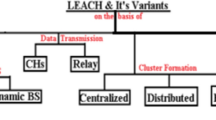Abstract
Mobile Data Collector device (MDC) is adopted to reduce the energy consumption in Wireless Sensor Networks. This device travels the network in order to gather the collected data from sensor nodes. This paper presents a new Tree Clustering algorithm with Mobile Data Collector in Wireless Sensor Networks, which establishes the shortest travelling path passing throw a subset of Cluster Heads (CH). To select CHs, we adopt a competitive scheme, and the best sensor nodes are elected according to the number of packets forwarded between sensor nodes, the number of hops to the tree’s root, the residual energy, and the distance between the node and the closest CH. In simulation results, we adopt the balanced and unbalanced topologies and prove the efficiently of our proposed algorithm considering the network lifetime, the fairness index and the energy consumption in comparison with the existing mobile data collection algorithms.








Similar content being viewed by others
Code Availability
Not applicable.
References
Meddah, M., Haddad, R., & Ezzedine, T. (2017). An energy efficient and density control clustering algorithm for wireless sensor network In Wireless Communications and Mobile Computing Conference (IWCMC), 2017 13th International (pp. 357–364). IEEE.
Meddah, M., Haddad, R., & Ezzedine, T. (2018). Residual energy and density control aware cluster head election in wireless sensor network. In 2018 32nd International conference on advanced information networking and applications workshops (WAINA) (pp 141–146). IEEE
El Fissaoui, M., Beni-hssane, A., Ouhmad, S., & El Makkaoui, K. (2020). A survey on mobile agent itinerary planning for information fusion in wireless sensor networks. Archives of Computational Methods in Engineering, 1–12.
El Fissaoui, M., Beni-Hssane, A., & Saadi, M. (2016). Energy aware hybrid scheme of client-server and mobile agent models for data aggregation in wireless sensor networks. In International conference on hybrid intelligent systems (pp. 227–232). Springer, Cham.
Dong, M., Ota, K., Yang, L. T., Chang, S., Zhu, H., & Zhou, Z. (2014). Mobile agent-based energy-aware and user-centric data collection in wireless sensor networks. Computer Networks, 74, 58–70.
El Fissaoui, M., Beni-Hssane, A., & Saadi, M. (2019). Energy efficient and fault tolerant distributed algorithm for data aggregation in wireless sensor networks. Journal of Ambient Intelligence and Humanized Computing, 10(2), 569–578.
Fissaoui, M. E., Beni-Hssane, A., & Saadi, M. (2018). Multi-mobile agent itinerary planning-based energy and fault aware data aggregation in wireless sensor networks [J]. EURASIP Journal on Wireless Communications and Networking, 2018(1), 92.
Xing, G., Wang, T., Xie, Z., & Jia, W. (2008). Rendezvous planning in wireless sensor networks with mobile elements. IEEE Trans. Mobile Comput., 7(12), 1430–1443.
Tashtarian, F., Moghaddam, M. H. Y., Sohraby, K., & Effati, S. (2015). On maximizing the lifetime of wireless sensor networks in event-driven applications with mobile sinks. IEEE Transactions on Vehicular Technology, 64(7), 3177–3189.
Salarian, H., Chin, K. W., & Naghdy, F. (2014). An energy-efficient mobile-sink path selection strategy for wireless sensor networks. IEEE Transactions on vehicular technology, 63(5), 2407–2419.
Wen, W., Zhao, S., Shang, C., & Chang, C. Y. (2018). EAPC: Energy-aware path construction for data collection using mobile sink in wireless sensor networks. IEEE Sensors Journal, 18(2), 890–901.
Abdolkarimi, M., Adabi, S., & Sharifi, A. (2018). A new multi-objective distributed fuzzy clustering algorithm for wireless sensor networks with mobile gateways. AEU-International Journal of Electronics and Communications, 89, 92–104.
Zhang, C., & Fei, S. (2020). A matching game-based data collection algorithm with mobile collectors. Sensors, 20(5), 1398.
Rao, X., Huang, H., Tang, J., & Zhao, H. (2016). Residual energy aware mobile data gathering in wireless sensor networks. Telecommunication Systems, 62(1), 31–41.
Ghosh, N., Banerjee, I., & Sherratt, R. S. (2017). On-demand fuzzy clustering and ant-colony optimisation based mobile data collection in wireless sensor network. Wireless Networks, 1–17.
Sert, S. A., Bagci, H., & Yazici, A. (2015). MOFCA: Multi-objective fuzzy clustering algorithm for wireless sensor networks. Applied Soft Computing, 30, 151–165.
Mehr, M. (2014). Cluster head election using imperialist competitive algorithm (chei) for wireless sensor networks. Int J Mobile Netw Commun Telemat, 4(3), 1–9.
Zhu, C., Wu, S., Han, G., Shu, L., & Wu, H. (2015). A tree-clusterbased data-gathering algorithm for industrial WSNs with a mobile sink. IEEE Access, 3, 381–396.
Younes, A., Badawi, U. A., Farag, T. H., Alghamdi, F. A., & Salah, A. B. (2018). A genetic algorithm to find the minimum cost paths tree with bandwidth constraint in the computer networks. International Journal of Applied Engineering Research, 13(10), 7472–7476.
Stephan, T., Sharma, K., Shankar, A., et al. (2021). Fuzzy-logic-inspired zone-based clustering algorithm for wireless sensor networks. International Journal of Fuzzy Systems, 23, 506–517. https://doi.org/10.1007/s40815-020-00929-3
Hu, S., Li, G., & Huang, G. (2021). Dynamic spatial-correlation-aware topology control of wireless sensor networks using game theory. IEEE Sensors Journal, 21(5), 7093–7102. https://doi.org/10.1109/JSEN.2020.3043748
Funding
This work was funded by Innov’Com Laboratory (Innovation of Communication and Cooperative Mobiles Laboratory), Created in 2011 under Code LR-11/TIC-03, its former name is 6 'such research unit created in 2005 under Code UR/11–05/05). The objectives of this Lab revolve around its contribution to the innovation of intelligent (cognitive), communicating, cooperative and mobile systems.
Author information
Authors and Affiliations
Corresponding author
Ethics declarations
Conflict of interest
The authors declare that the research was conducted in the absence of any commercial or financial relationships that could be construed as a potential conflict of interest.
Data Availability
The data supporting the conclusions of this paper will be made available by the authors.
Autthor Contributions
M-M and R-H developed the methodological proposal and data analysis, described the conclusions and references, realized the literature review and wrote the part of the theoretical frame. T-E read and approved the final manuscript.
Additional information
Publisher's Note
Springer Nature remains neutral with regard to jurisdictional claims in published maps and institutional affiliations.
Rights and permissions
About this article
Cite this article
Meddah, M., Haddad, R. & Ezzedine, T. An Efficient Mobile Data Gathering Method with Tree Clustering Algorithm in Wireless Sensor Networks Balanced and Unbalanced Topologies. Wireless Pers Commun 123, 3699–3717 (2022). https://doi.org/10.1007/s11277-021-09309-y
Accepted:
Published:
Issue Date:
DOI: https://doi.org/10.1007/s11277-021-09309-y




